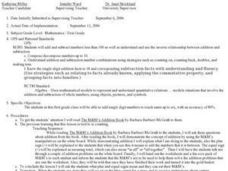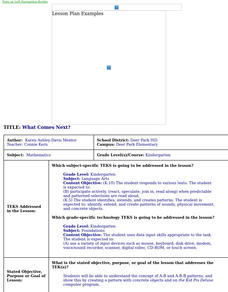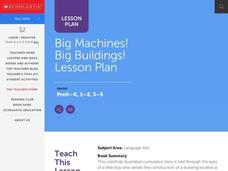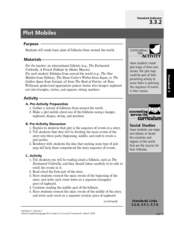Curated OER
Using Dreams in Writing
C.S. Lewis’s That Hideous Strength provides the model for using dreams in narrative writing. After a discussion of the purpose of dreams in Lewis’s tale, class members craft a story in which their dreams play an essential role.
Curated OER
Create a Food Chain
Learners discover the connection between plants and animals by discussing simple food chains. Students explore what may happen when parts of a food chain are removed. Learners wrap up the lesson by writing a story about a food chain.
Curated OER
M & M Addition
Eat your math manipulatives, are you serious? Yup, Learners listen to the story The M & M's Addition book, add single digit numbers to reach sums up to six, and demonstrate addition and subtraction number combinations using several...
Curated OER
So Foul and Fair a Play
Students watch various interpretations of Shakespeare's Macbeth in film. In groups, they examine the setting, characters, music and sequence. They compare and contrast the various films and discuss the differences. They write an essay on...
Curated OER
Espionage and Sedition Acts: Mock Trial
Bring to life the severity of the Espionage and Sedition Acts through a mock trial. Learners have prior knowledge of WWI and the context of these acts. An anticipatory set gets the class discussing the ethics of wartime dissension, and...
Curated OER
Fibonacci Numbers
Students calculate the Fibonacci sequence of numbers. Through the use of Fibonacci numbers in flowers, leaves, fruits, vegetables, pine cones, and other forms of nature; students explore how Fibonacci numbers occur in nature. Then they...
Curated OER
Reviewing Main Events in Fiction
Young scholars analyze elements of fiction while reading. In this reading analysis lesson, students read specific texts and retell the information they remember. Young scholars discover how sequential storytelling works.
Curated OER
Picture This!
First graders watch the teacher model how to draw pictures and write words in a First, Next, Then, Last - 4 block graphic organizer. They write and draw in their own 4 block papers.
Curated OER
What Comes Next?
Students explore the concept of A-B and A-B-B patterns, and show this by creating a pattern with concrete objects and on the Kid Pix Deluxe computer program.
Curated OER
Big Machines! Big Buildings! Lesson Plan
Students read a book and understand the cumulative events of the story through sequencing. In this lesson plan about cumulative texts, students are able to read the story and understand the sequence of the events. Students listen to the...
Curated OER
Plot Mobiles
Learners read folktales and identify the plot of the story by making a mobile. In this inventive and colorful lesson, students listen to a variety of famous folktales, and practice identifying the plot. Then, they work together to create...
Read Works
Retelling A Life
Use comic strip format to help organize and sequence events in a story. The lesson here focuses on The Story of Jackie Robinson: Bravest Man in Baseball; however, this strategy could be used for summarizing any text. Pupils must choose...
Read Works
Lesson 2: Retelling a Life
Show your class how to indicate which events in a persons life are more important by creating a timeline of Amelia Earhart's life based on the biography Lost Star: The Story of Amelia Earhart. Class members will not only have to...
Curated OER
If You Give a Mouse A Cookie
Young scholars are read the book "If You Give a Mouse a Cookie" and develop their own story. They use a literature wheel to determine what the mouse will want next. They share their wheels with a friend.
Curated OER
Story Of Silk
Learners discover the use of silk found in China while conducting research using a variety of resources. They read "The Empress And The Silkworm" as a literature study to establish the context of the lesson. Then students unwrap a cocoon...
Curated OER
Keep the Lights Burning, Abbie -The Story
Students explore lighthouses in literature. In this reading lesson, students read Keep the Lights Burning, Annie as well as Birdie's Lighthouse. Students participate in pair/share activities regarding plot and literary devices. Student...
Curated OER
Historical Success Stories: Banneker, Blackwell, Drew, and Faraday
Fourth graders investigate how all races and religions have contributed to US history by looking at the scientists Elizabeth Blackwell, Benjamin Banneker, Charles Drew, and Michael Faraday. They research these scientists individually and...
AtoZ Teacher Stuff
Pumpkin Life Cycle
From seed to jack-o-lantern, young scholars walk step-by-step through the life cycle of pumpkins with this fun art and science activity. After first participating in a shared reading of the children's book Pumpkin,...
Code.org
Practice PT - Encode an Experience
Encoding What I did Last Summer. Class members develop a way to encode a personal experience using a top-down approach to determine components and sub-components of their experience They then pick one portion of the experience and go...
Curated OER
Narrative Cartoons
Students create narrative cartoons based on the activities of the Peace Corps. In this narrative cartoons lesson plan, students create comic strips where they draw and write about various activities that the Peace Corps is involved in.
Curated OER
A Walk Around the School: Mapping Places Near and Far
After reading Pat Hutchins’ Rosie’s Walk, have your young cartographers create a map of Rosie’s walk. Then lead them on a walk around the school. When you return class members sequence the walk by making a list of how the class got from...
Curated OER
The Carving of Old Jack
In this comprehension worksheet, 3rd graders read directions on how to carve a pumpkin. Students answer questions related to sequencing, definitions, and understanding of the story to demonstrate comprehension.
Curated OER
Comprehension Questions: The City of Ember, Chapter 20
Comprehension questions for the last chapter of Jeanne DuPrau's book The City of Ember assess factual recall, sequencing skills, and inference about the text. Note: One question about point of view is based on a sentence not related to...
Virginia Department of Education
Physical and Chemical Properties of Water
How can you effectively provide detailed concepts of water properties to your high school class in a way they find exciting and challenging at the same time? By letting them play, of course! Through a variety of...
Other popular searches
- Story Sequencing Worksheets
- Sequencing a Story
- Picture Story Sequencing
- Story Sequencing Halloween
- Story Sequencing Activities
- Story Sequencing Rubric
- Sequencing Story Events
- Short Story Sequencing
- Story Sequencing Exercises
- Story Sequencing Pictures
- Story Sequencing Map
- Sequencing Story























